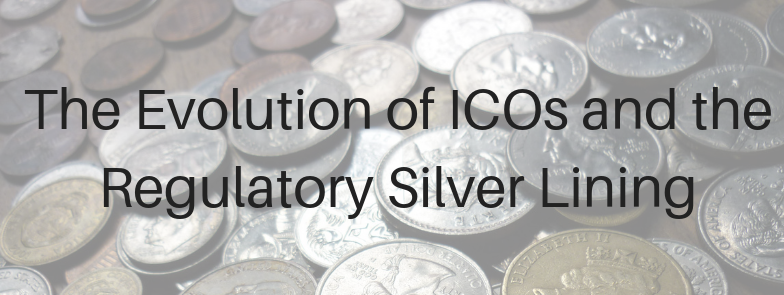We’ve come a long way since Mastercoin, the first reported initial coin offering (ICO) that took place in 2013. Those five years seem like eons considering the incredible progress that has been made since. From ICOs to security tokens to smart assets and digital futures – the evolution of digital assets goes way beyond the renaming of “ICO”.
ICO 1.0
The original ICOs were actually not designed to be used the way they are often used today – having been irresponsibly and quickly merged into the capital markets. ICOs were originally developed to build automated, decentralized network infrastructure that could provide trustless value transfer and autonomous incentivization leading groups toward a shared goal.
This was revolutionary because while the internet made everything free, from music to movies to software and more, blockchain was a mechanism that gave everything back its value. However, it didn’t take long for enterprising minds to figure out how to make a ton of money using this technology, as can often be expected of any innovation.
ICO 2.0
2017 saw the technology applied to fundraising on a massive scale – and the ICO became perhaps the biggest thing ever for non-dilutive equity. Ethereum smart contracts made it easy for almost anyone to simply build a few microservices-esque smart contracts and raise millions, without the need to know any intricate coding. Following this, the number of ICOs skyrocketed, and in 2017 ICO funding even surpassed venture capital funding for the year. In the eyes of an issuer – this was way better than traditional non-dilutive equity because there was no need to give investors any rights whatsoever.
It’s clear what was in it for token issuers. For starters, they were able to present what is often not much more than an idea, make a compelling argument, lay it out in a white paper and generate enough hype to attract a plethora of investors to line up and support it.
ICO 2.1 – The STO
Eventually – it was clear that the “free money” era of the ICO 2.0 would come to an end. Enter: the security token offering (STO).
While this sounds more legitimate at first, because it recognizes that there is a need for some kind of regulatory oversight, the reality is that many of these projects have done little more than simply fill out a Regulation D form and still often provide investors with no rights, dividends, interest or equity. In many cases, these security or payments tokens can end up being just an extra step of friction in the process of acquiring a new user. Regulation D became popular because it exempts compulsory registration with the U.S. Securities and Exchange Commission (SEC). However, it also means that issuers must provide potential investors with documentation such as Private Placement Memorandums (PPM) and that offerings are subject to federal securities laws such as anti-fraud and civil liability.
Despite the extra paperwork, these offerings are not automatically compliant just because they are called STOs. Some absolutely crucial aspects of compliance are regularly ignored:
Location, location, location.
You’ve probably noticed the droves of people heading to Gibraltar, Malta, Switzerland and other jurisdictions to launch their ICOs with the goal of easing the compliance burden of their offerings. But the cold hard truth is – securities regulations have very little to do with where your offering is based – it’s about where the investors are. Regulations are not harmonized across borders. If one U.S. citizen buys that token, even on an exchange, – the issuer is responsible for ensuring that the token is fully compliant with the U.S. Securities Act.
Sanctions
There are liabilities for securities offering beyond just the Securities Act – trade sanctions for example which cannot be ignored. While you may be familiar with the Global Politically Exposed Persons (PEP) watchlist that most “lite-KYC” providers claim to review, this is something completely different and extremely important. Breaching the U.S. Patriot Act by allowing someone from Libya, Iran, or a known terrorist buy your token off of Ether Delta can land you in much hotter water than a Securities Act violation.
Lock Up Periods
A security token in the U.S. must also consider the Exchange Act or similar legislation in other countries. While Reg D requires a 12-month lock-up period (or 6 months if you meet the criteria of the Exchange Act) the Offering Memorandum (OM) is typically 4 months – although two legitimate STOs (TokenFunder and Impak Finance) are explicitly not allowed to let their tokens trade at all.
KYC is Not One-Size-Fits-All
Just like securities laws differ – so do KYC rules. In Switzerland for example – electronic signatures are not sufficient to purchase equity – the company requires a physical signature. Whereas in Canada, photo ID is not sufficient, there must be two credit checks run by two different agencies before the purchase is made. A truly compliant token offering must ensure that each investor is onboarded to the bare minimum standards – or greater – required by the jurisdiction where the investor is domiciled.
Looking for financial grade KYC and AML in an enterprise ready API?
iComply offers global screening for humans, corporations, and blockchain transactions in a single REST API.
Book a demo with one of our specialists to learn more.
ICO 3.0 and the Silver Lining
Interestingly, many of the issues mentioned above can actually be solved with the very same technology that has created these regulatory holes in ICOs. Blockchain can provide increased integrity and transparency compared to what the traditional financial markets are able to deliver today.
The demand for this technology in the capital markets shows us that traditional stock exchanges and crowdfunding platforms are unable to deliver the value that new early-stage issuers and global investors are seeking. That is true, global access to capital, liquidity for investors and the ability for entrepreneurs of all kinds to brings their ideas into the world – not just those people with connections or capital at their disposal. Great ideas come from everywhere, and no one should feel the need to skirt regulation, putting themselves and their investors at risk.
This is why iComply was created. By utilizing fully compliant tokens for ICOs, issuers are able to gain investor-confidence more easily and increase participation in their offerings from a variety of investors, including institutional investors.
Looking for an end-to-end token management studio?
iComply’s token compliance platform, Prefacto enables issuers to capture the value of blockchain asset management with multi-jurisdictional compliance automation for over 150 countries.
Book a demo with one of our specialists to learn more.
About iComply Investor Services Inc.
iComply Investor Services Inc. (iComply) is an award-winning software company focused on reducing regulatory friction in the capital markets. With powerful data, verification, tokenization solutions, iComply helps companies overcome the cost and complexity of multi-jurisdictional compliance to effectively access new markets. Learn more: iComplyIS.com
How to Implement Automated KYC Verification for Your Business
In today's fast-paced digital world, navigating the complex regulatory landscape can be a challenge for financial institutions and businesses. One critical aspect of compliance is Know Your Customer (KYC) verification. Manual KYC processes can be time-consuming, prone...
iComply Investor Services Inc. Forms Strategic Partnership with Qoden to Enhance KYC Processes
Vancouver, Canada - iComply Investor Services Inc., a leader in compliance technology, is excited to announce a strategic partnership with Qoden, a premier technology company specializing in advanced trading platform solutions. This partnership is centered around...
Q3 2022 Regulatory Updates
Regulatory actions and industry updates from financial authorities and regulators around the globe in Q3 2022




